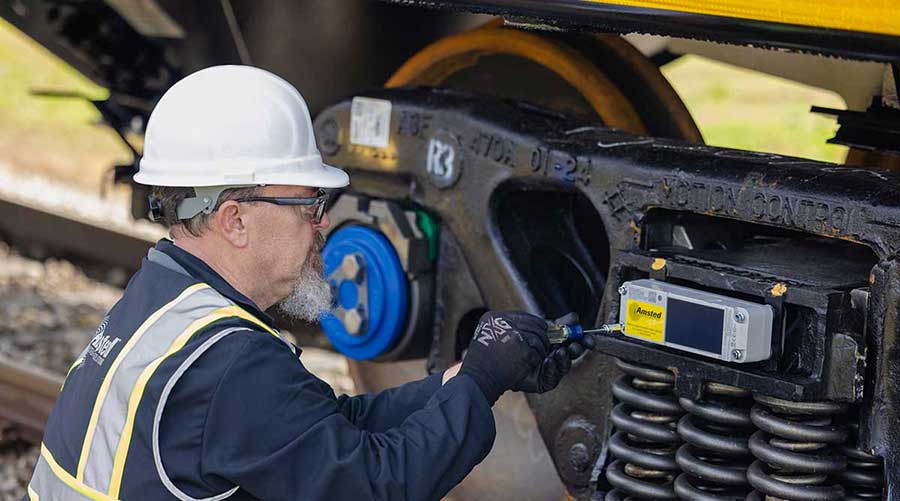Stay updated on news, articles and information for the rail industry
 railPrime
railPrime
August 2013
Rail News: BNSF Railway
Keystone Pipeline is not key to importing Alberta crude oil — by Fritz Kahn (Guest Comment)
By Fritz R. Kahn
The flow of crude oil from the Williston Basin's Bakken shale field, centered in North Dakota, has confirmed that its transportation by rail is a viable alternative to its movement by pipeline. The U.S. Energy Information Administration reports that the total takeaway capacity from the Williston Basin grew from about 678,000 barrels a day at the end of 2011 to over 1.1 million barrels a day by the end of 2012. Transportation by rail represented most of this expansion, increasing from an estimated 265,000 barrels a day in 2011 to approximately 660,000 barrels a day in December 2012. The principal beneficiary has been BNSF Railway Co., whose daily volume of crude oil is expected to reach 500,000 barrels moving in eight unit trains by the end of this year.
The experience in the Williston Basin renders questionable the need for the Keystone XL pipeline. The proposed 1,179-mile, 36-inch diameter crude oil pipeline would extend from Hardisty, Alberta, Canada, to Steele City, Neb., where it will connect with an existing pipeline to Cushing, Okla., a major crude oil marketing and refining hub, and with a pipeline under construction to reach Nederland, a Kansas City Southern station on the Gulf Coast. It is expected to cost $5.3 billion and will take several years to complete.
Since the Keystone would cross an international border, its construction requires the president's approval. President Obama is being urged to deny its approval because the Alberta oil sands' heavy crude oil, or bitumen, which would flow through it, is said to be dirty and corrosive.
CN and Canadian Pacific already reach the Alberta oil sands producing areas, and their cross-border transportation of bitumen requires no presidential approval. Their lines or those of their connecting railroads reach virtually all refineries in the United States, including those on the East and West coasts, which would derive little benefit from the Keystone XL pipeline. The bitumen would reach Gulf Coast refineries far more rapidly when transported in unit trains of tank cars than if it were pumped through the Keystone.
To be capable of being transported by the Keystone XL pipeline, the bitumen would need to be diluted with other petroleum products, 30 percent diluent to 70 percent bitumen, reducing the amount of bitumen reaching the destination. Bitumen can be shipped by rail without any diluent in insulated tank cars and with only 15 percent to 20 percent diluent in uninsulated tank cars. The diluent is a return load if used in the movement of bitumen by rail, but not if transported via the Keystone. Some CN- or CP-originated bitumen already is reaching U.S. refineries, and more would be moving by rail but for the shortage of tank cars, the manufacture of which has an approximate 18-month backlog.
The pipeline transportation of crude oil is inherently more cost effective than its movement by rail. Shipping the bitumen to the Gulf Coast by pipeline, the State Department estimates, costs about $10 per barrel, while shipping by rail costs about $30 per barrel.
The proponents of the Keystone XL pipeline are gambling that the differential in the price of the Alberta sands bitumen, on the one hand, and either domestic light oil or imported heavy oil on the other, will be insufficient to permit the bitumen's movement by rail. That was the case as recently as July 10, 2013, when Western Canada Select, the benchmark blend that includes bitumen, was selling for $90.11, or only $16.30 below the $106.41 price of West Texas Intermediate, which includes the Bakken shale oil; and only $12.13 below the $108.43 price of Brent — the latter being the benchmark blend and which includes the Venezuelan oil.
In the beginning of May, the spot price of West Texas Intermediate was $93.70 per barrel; Brent Oil, $100.33. With Western Canadian Select priced below $60 per barrel, the differential was broad enough to encourage the movement of bitumen by rail.
Crude oil prices, however, fluctuate, and it is the relationship between them that will determine whether — if it were approved by the president — the construction of the Keystone XL pipeline made any sense or whether the bitumen should have continued to move by rail.
A preliminary environmental report by the State Department concluded that the bitumen will move, regardless — if not by the Keystone XL pipeline, then by rail. As of now, the continued movement of bitumen by rail seems to make the most sense.
Fritz R. Kahn is a Washington, D.C., lawyer specializing in domestic transportation regulatory issues. A former general counsel for the Interstate Commerce Commission, Kahn currently practices almost solely before the Surface Transportation Board, representing short lines, shippers and governmental bodies.


 LRW Honors Amtrak’s Acheson As Railway Woman Of The Year
LRW Honors Amtrak’s Acheson As Railway Woman Of The Year
 From Editor-In-Chief Foran: Of Gender Equity And Inclusion
From Editor-In-Chief Foran: Of Gender Equity And Inclusion
 Spotlight On Some Of Today’s Rail Safety Products
Spotlight On Some Of Today’s Rail Safety Products
 Women of Influence in Rail eBook
Women of Influence in Rail eBook







